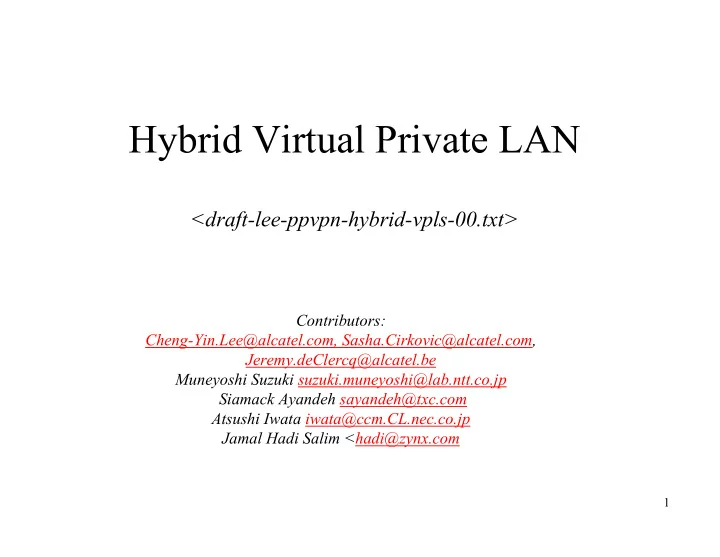

Hybrid Virtual Private LAN <draft-lee-ppvpn-hybrid-vpls-00.txt> Contributors: Cheng-Yin.Lee@alcatel.com, Sasha.Cirkovic@alcatel.com, Jeremy.deClercq@alcatel.be Muneyoshi Suzuki suzuki.muneyoshi@lab.ntt.co.jp Siamack Ayandeh sayandeh@txc.com Atsushi Iwata iwata@ccm.CL.nec.co.jp Jamal Hadi Salim <hadi@zynx.com 1
Motivation • minimal impact on existing provider’s network infrastructure (PEs, Ps, L2PE) and CEs • Bridging of customer’s traffic shall be performed in a scalable manner for many customers and sites spanning LAN/MAN/WAN • A customer’s L2VPN control and forwarding shall not impact other customers • Does not make it difficult to offer service with SLAs • Shall meet majority of end customers requirements now, while PE-based VPLS, would take time to be standardized, experimented with, and more challenging to scale for many emulated LANs and sites spanning WAN 2
Goal • Specify interoperable mechanisms (new and as much as possible leverage existing technologies) for Hybrid VPLS – Specify interoperation of CLEs and PEs as well as PEs and PEs, including mechanisms to reduce provisioning – describe interoperation of CEs and CLEs (to be compliant with existing IEEE specifications) 3
Context of proposal Layer 2 Layer 3 Martini PE- based VPLS PE/L2PE- RFC 2547 L2VPN based VR DTLS Hybrid VPLS site-to-site CE/CLE IPsec VPNs CE-based VPL -based Note: CLE – Customer Located Equipment (Provider owned) PE-based VPLS – PW and bridging at PEs CE-based VPL – PW and bridging at CEs/CLEs Hybrid VPLS – PW at PEs, bridging at CLEs (VLAN tags used as mux ID 4 between CLE-PE)
Building an emulated LAN using multiple point to point Ethernet Emulated LAN P2p AC AC EthoPSN CE2 PE2 CLE2 CE1 CLE1 PE1 Eth Eth Eth Eth P2p EthoPSN CLE5 PE3 PE4 Eth Eth Eth Customer Customer Premises Premises Provider’s Network � CLEs connected by point to point Ethernet (appear as virtual port to CLEs) � P2p Ethernet provisioned at PEs by provider - trivial provisioning at CLEs, hub CLEs only need to know number of remote sites � A CLE bridges traffic from one virtual port to another, no bridging on PEs in the 5 provider’s network.
Service Delimiters • Service delimiter between CE & CLE – Ethernet frame (multi-point switching) • Service delimiter between CLE & PE – Multiplexing ID (e.g. VLAN tag, Stacked VLAN tag, MPLS VC) and Note: In the case of connection to one remote CLE only, Mux ID is not necessary – Ethernet frame (p2p “cross-connect”) 6
Multiple p2p Eth over an access link A A P P P A P2P A A P P EthoPSN CE2 CLE2 CE1 PE2 CLE1 PE1 Eth Eth Eth Eth B B B Q Q P2P Q EthoPSN CLE5 CE5 PE3 PE4 Eth Eth Customer Customer Provider’s Network Premises Premises � Multiplexing ID has local significance between CLE and PE only � If the same access link is used to connect to each remote site, need to identify the different p2p Ethernet at access link with multiplexing identifiers e.g. VLAN/Stacked VLAN tags 7
Peering CE Routers over an emulated LAN P2P EthoPSN CE2 CLE2 Eth CE1 CE1 PE2 CLE1 PE1 Eth IPoPSN P2P EthoPSN FR CE3 CLE5 CE5 PE3 PE4 Eth PSN CE4 Broadcast network � Peering IP routers with different access links over a broadcast network. � All other CEs sees CE3 on a broadcast network and can peer with CE3 over the emulated LAN � Connect CE3 via a p2p IPoPSN to the emulated LAN � If a new CE4 router is added, CE4 can peer with other CEs with one AC connected 8 to the emulated LAN
Service Delimiters • Service delimiter between CE & CLE – Ethernet frame (multi-point switching) • Service delimiter between CLE & PE – Homogeneous p2p • Multiplexing ID (e.g. VLAN tag, Stacked VLAN tag, MPLS VC) Note: In the case of connection to one remote CLE only, Mux ID is not necessary • Ethernet frame (p2p switching) – Heterogeneous p2p • Multiplexing ID • IP packet (IP address <-> link layer address mapping) – Alternative 1: map at CE (mp L3 switching at CE) – Alternative 2: map at CLE (p2p switching at PE) – Alternative 3: map at PE (mp L3 switching at PE) • Service delimiter between CE & PE – IP packet 9
Motivation for Peering CE routers over an emulated LAN (with different access links) • Reduce error prone provisioning at CE routers • If a new CE4 router is added, CE4 can peer with other CEs with one AC connected to the emulated LAN • Reduces link state database (cf peering CEs over many p2p links or over different subnets) • Reduces routing control messages • Forwarding optimality no worse than connecting CEs in different subnets 10
Next steps • Select mechanism(s) to automate trivial provisioning at CLEs, reduce provisioning of PEs for Hybrid VPLS • Separate draft for heterogeneous PW, PW and router peering mechanisms? • Evaluate need and issues of split horizon forwarding vs spanning tree 11
Backup slides 12
Using multiple access links or additional ports at CE/CLE Broadcast domain CE2 PE2 CLE2 CLE1 PE1 Eth Eth CLE5 CE5 CLE3 PE3 PE4 Eth Eth CLE4 PSN Eth � If a different access link is used to connect to each remote site (e.g. at CLE5), or CLE2 tags the traffic from different CE2 ports, no changes required at CLEs, no need for multiplexing identifier at access network � otherwise if only one physical link is connected to the network, a multiplexing 13 identifier is required
CE Bridges with different Access Links P2P EthoPSN CE2 CLE2 Eth CE1 CE1 PE2 CLE1 PE1 Eth P2P P2P EthoPSN EthoPSN FR CE3 CLE5 CE5 PE3 PE4 Eth PSN CE4 Emulated LAN � CE and CLE Bridges may have different access links (e.g. Eth and FR) � Connect CE3 via a p2p EthoPSN to the emulated LAN � CE3 switches/bridges traffic as defined by existing specifications 14
Recommend
More recommend